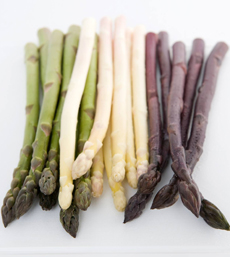TIP OF THE DAY: Purple Asparagus, White Asparagus
|
It’s spring, it’s asparagus season, and your specialty produce purveyor just may have wondrous, fresh asparagus in the non-traditional colors of purple and white.
Low in calories, asparagus is a good source of folic acid, potassium, amino acids and dietary fiber. But people who love their flavor don’t always concern themselves with these details: They just want their spears blanched, grilled, raw, sautéed, steamed or otherwise prepared. All asparagus should be firm to the touch, with closed tips. The diameter of spear does not matter; the flavor remains the same. Asparagus will keep for up to seven days in the refrigerator, wrapped in a damp paper towel; but serve them promptly after purchase for the best flavor. WHITE ASPARAGUS White asparagus has always been considered a delicacy, not just for its color but because of the expense—often double that of green—which is a function of the extra effort required to grow it. |
Asparagus lovers: look for fresh white and purple spears. Photo courtesy Australian Asparagus Growers. |
|
|
The spears must be grown underground or in the dark, without exposure to sunlight. The sun engenders photosynthesis and the development of chlorophyll, which creates asparagus’ conventional green color. To keep them white, asparagus were conventionally grown by “hilling” the soil into a mound, the earth creating a barrier to light. As soon as the spear poked its head up from the mound, specialist workers would cut deep into the mound to harvest it. But “blind harvesting” increased the risk of injuring the spears. Modern growers now use black plastic “polyhouses” or “igloos” constructed over the crop to ensure that the spears are not exposed to sunlight. These white asparagus can be harvested above the ground cleanly and efficiently, without damaging the spears. White asparagus have a thicker outer layer that can be easily removed, if needed, with a vegetable peeler. Note that canned white asparagus are no more interesting than canned asparagus and most other canned vegetables. If you have a chance to purchase white asparagus, its wonderfully distinctive flavor will make the high price more palatable. |
||
|
|
PURPLE ASPARAGUS Purple asparagus are larger, sweeter and tastier than the conventional green types of asparagus. The flesh is creamy white, like green asparagus. The purple skin color comes from the high levels of anthocyanins (potent antioxidants) in the spears. Purple asparagus have a lower fiber content than green or white asparagus, making the spears more tender. Even though the spears are thicker than green or white asparagus, the very bottom of the spear can be eaten (more for your money!). Alas, they turn a deep green-bronze color when cooked. So enjoy them raw in bean, green or grain salads; or as crudités with dip. Try blanching them or adding to stir-frys at the end of cooking, to see if you can maintain the color. [Source: Asparagus.com.au] To peel or not to peel? We’ve never had the need to peel asparagus, but some cooks do so to ensure extra tenderness. Snap versus trim? Snapping off the white ends creates uneven spears. Use a knife to trim them. |
|
|
|
||




